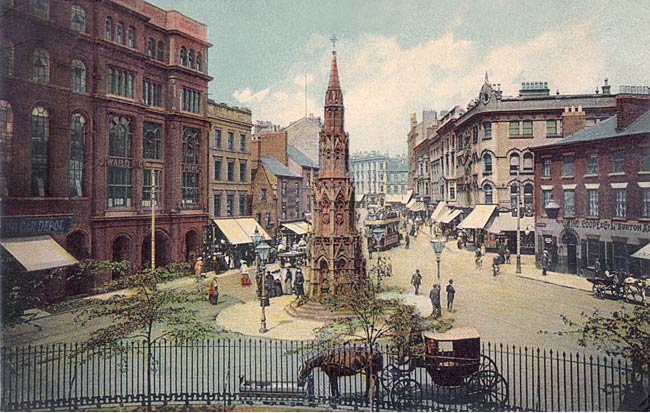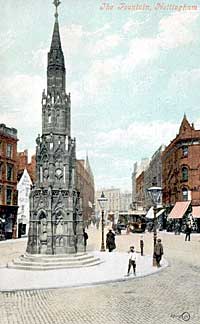< Previous | Contents | Next >
Church Gate, Albert Street, Lister Gate, Carrington Street
Church Gate the tiny street leading out of the north side of Low Pavement is really of remarkable historical interest, for in conjunction with St. Peter's Church Side it was the only exit from the south side of this part of the town until the formation of Albert Street in the middle of the 19th century. Narrow as these thoroughfares are, they were narrower still when they were thronged with traffic, for they were considerably widened even so late as 1884. Traffic from the market had to find its way down Wheeler Gate, then along St. Peter's Church Side, take a sharp turn to the right and so into Low Pavement and Lister Gate. There was barely room for one cart in this passage and constant disputes and wrangles as to precedence took place between travellers and waggoners which led to all sorts of disturbances. Upon one occasion the axle of a cart broke and the whole traffic of the town was completely held up until it could be cleared away. To reduce this chaos, in 1840 a policeman was placed on point duty to direct the traffic and he was, I believe, the first point man in Nottingham.
Somewhere about here stood the Jews' synagogue. The Jewish history of Nottingham is extremely obscure, but it seems probable that there was a synagogue in the town before the reign of Edward I. It is disputed whether it stood at the corner of Church Gate and Low Pavement or whether it stood in what is now Lister Gate about opposite No. 4. In the Borough Records there is this reference "A.D. 1391 Cottage of Henry Plumtree formerly the Jews' synagogue (Schola Judaeorum) in the street leading from the church of St. Peter's to the Friars Minor" and Mr. Granger was of the opinion that it referred to Church Gate.
At the foot of Low Pavement we come to Albert Street, a quite modern thoroughfare formed in 1846, but now of tremendous importance. In the course of its formation some ancient half-timbered houses with gabled roofs facing on to St. Peter's Square were pulled down in one of which Dr. Deering, the historian, died in poverty in 1749. Dr. Deering was a strange man. Believed to have been born in Germany, he came to England in 1735, settled in Nottingham as a medical practitioner, but he never seemed to succeed and quickly he sank into absolute poverty. He conceived the idea of writing a history of Nottingham and John Plumtree gave him a vast amount of assistance, but he did not live to see the publication of his work for he died while it was still in manuscript and it was published by Aiscough the printer a couple of years after his death. He appears to have been a somewhat touchy individual and difficult to help, probably this was largely due to the fact that he was a foreigner and did not thoroughly understand contemporary British manners and customs, but at any rate the history which he left is an exceedingly valuable book and when one considers that it is only the first draft of his work and that probably had he lived he would have made a good many alterations and corrections one realises even more its value.

Lister Gate and the Walter Fountain, c.1905.
Lister Gate is an old thoroughfare going back as far as 1303 when it was referred to as "Litster Gate " or Dyers Street, the dyers no doubt congregated here in order to make use of the waters of the river Leen. It was of no great importance in ancient days and as late as 1641 it was a mere quagmire with an open sewer running down it and a plank pathway which had something of the nature of a bridge down its side to enable foot passengers to get about. In 1607 there were a set of stepping stones "near John Perry's door" leading from the bottom of Low Pavement to Castle Gate, but with the advent of railways and all that they meant, Lister Gate leaped into importance. Still for thirty years little seems to have been done to improve it and the area round about Grey Friar Gate seems to have been a bog and Lister Gate itself was a steep gradient leading down to it. This bog was called "The Sough" and in 1778 a woman named Shaw, daughter of the landlord of the Elephant and Castle in Hounds Gate fell into it one evening when in a state of partial intoxication. She remained there until the following morning when she was noticed by a labourer going to work. He endeavoured to extricate her, but while he was so engaged she heaved a deep sigh and died. In 1868 Lister Gate was widened, the bog was filled in and the gradient made easy. It is interesting to remember that at this date it was proposed to move Messrs. Jalland's wine and spirit vaults, presumably the modern "Weavers Arms," back en bloc, and plans were prepared for doing so by an American engineer. However, the scheme was abandoned and eventually the building was removed brick by brick and re-erected a dozen feet to the rear. However, to-day the street is none too wide for the traffic that it is called upon to bear.
In a yard behind No. 9, Lister Gate will be found a portion of the town wall of Henry II's time. It is apparently a buttress and must have helped to uphold that portion of the defence which came down Low Pavement.
Carrington Street was formed in 1829 and terminates at Queen's Road. It gets its name from Lord Carrington who was a descendant of the founder of the Collin's Hospitals. Before he was raised to the Irish Peerage in 1796 he was Mr. Smith, M.P., the eminent banker and was a very valuable member of the community. Of Collin's Alms Houses we shall have an opportunity of saying more in another place, but the set of twenty tenements erected in Carrington Street between 1830 and 1840 are part of a very fine charity which is doing extraordinarily good work in the town and the obelisk at the corner of Grey Friar Gate with its inscription "Erected A.D. 1866 by the acting trustee of the charity to perpetuate the memory of Thomas Smith, Esquire, to whom as executor was entrusted the charge of founding Abel Collin's and Jonathan Labray's Alms Houses in this town, namely Collins A.D. 1709, Labray's A.D. 1726, a trust which he fulfilled with the strictest fidelity. He died January 8th, 1727, aged forty-five years, and is interred in St. Mary's Church in Nottingham. This estate originally purchased by him A.D. 1722, out of trust funds has, through the lapse of time, attained its present importance, and comprises within its limits one of the principal thoroughfares of the town of Nottingham," is worth noticing.

The Walter Fountain on Lister Gate in 1888. It was removed in the 1950s when the road was widened.
In front of this stands the Walter Fountain, a great Gothic structure erected in 1866 from the designs of Mr. Sutton to commemorate Mr. John Walters' association with Nottingham. Mr. Walters was a proprietor of The Times and in 1841 he stood as a Conservative candidate for Nottingham. The main question upon which the election hinged was the new Poor Law which was extremely unpopular with the people. Great excitement prevailed and eventually Mr. Walters was elected by a majority of 238. After Mr. Walters' death his son, John Walters, Junior, also became M.P. for Nottingham and so the connection of the family with the town was maintained for some time.
There is an interesting note in the "Farringdon Diary" about the profits of The Times for under July 25th, 1796 it is recorded that "The Times earned £24,000 in three years. It was divided in sixteen shares of which Mr. Walters had eleven. Harris the proprietor of the Covent Garden Theatre paid Mr. Walters £100 per annum that his theatre should be well recommended in The Times."
